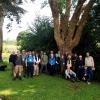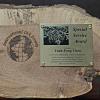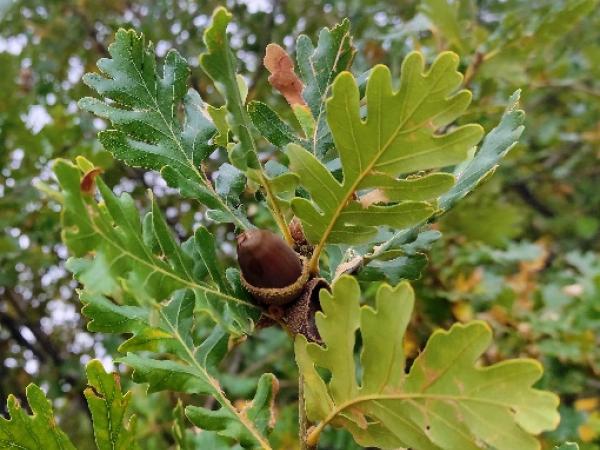Editor's Picks
Plant Focus
Quercus stenophylloides (local name 狹葉櫟 (xiá yè lì), or Arishan/Alishan oak) is a medium-sized evergreen oak (15–18 m tall) restricted to central and northern Taiwan. Boles can become quite large, reaching up to 40 cm in diameter. On Taiwan, the species is thought to be confused with Quercus salicina (a suspected closely related species from Japan and Korea), as it also occupies substrates more typical for this species, such as sandstone ridges.

The branchlets of Q. stenophylloides are slender, gray, lenticellate, and glabrous. Its petioles are up to 1.5–2 cm long and glabrous. Leaves are oblong-elliptic to lanceolate, 7–12 cm long and 1.5–3.5 cm broad, generally with a leathery texture. Abaxially, leaves are covered with a whitish meal-like powder and prostrate simple hairs but are usually glabrescent. The adaxial surface is light green.

The leaf apex is acuminate to caudate, and its base is narrowly acute to rounded. The leaf margins are dressed with short, awnlike serrations. Leaves can have up to 11–13 pairs of secondary veins, which extend into the leaf serration itself. Tertiary veins on the abaxial surface are inconspicuous to obscure. Pendulous male inflorescences are often very abundant and give the tree crown a drooping look early on in the growing season, together with the freshly flushing leaves. Female inflorescences are 2–2.5 cm long.

Cupules generally appear in clusters of 6–7, are cup-shaped and up to 1–1.5 cm high and 1.2–1.5 cm across. Cupules can enclose up to ½ of the nut. The exterior and interior of the cupule are both grayish-velutinous. The cupule wall is very thin, mostly less than 1 mm thick.

The exterior of the cupule is covered with bracts, arranged in 6 or 8 rings with slightly dentate margins. Nuts are glabrous, ellipsoid, and 1.7–2 cm long and up to 1.5 cm in diameter. Scars are flat and small, up to 5 mm in diameter. The stylopodium (acorn apex) is persistent and conspicuous in this species, bearing 3 clear rings.

Flowering occurs from April to May. Fruiting occurs roughly from September to October of the year following the year of the flowering season (i.e., acorns mature in 2 years). Ripening acorns turn from fresh green to dark brown.

This oak occurs throughout broad-leaved evergreen forests in upland areas, between 1,100 and 2,600 m above sea level, although it is occasionally reported from lowland areas. It is rated as hardy to zone 9 of the USDA system, but it is not often found in cultivation.

Acorns of this species form an important food source for Asiatic black bears (Ursus thibetanus formosanus). Together with Q. glauca and Q. tatakaensis, acorns from Q. stenophylloides form the main sources of food in the form of hard mast during the winter months, when protein-rich food is scarce. This species-specific preference and dietary importance highlights the need to preserve an intact tree flora on Taiwan, and emphasizes the role oak species play in survival of the large fauna elements.

The epithet stenophylloides means “resembling stenophylla”. Hayata notes in his description that the species is similar to Q. stenophylla (Blume) Makino, a synonym of Q. salicina Blume; stenophylla means narrow-leaved, derived from the Ancient Greek: στενοϛ (stenos) = narrow, and φυλλον (phillon) = leaf. The common name derives from the Arishan (or Alishan) mountain range in central Taiwan.

Further reading
Beaulieu, A. le Hardÿ de and T. Lamant. 2010. Guide illustré des chênes. Geer, Belgique: Edilens. Tome 1: 700–703.
Boufford, D.E., H. Ohashi, T.C. Huang, C.F. Hsieh, J.L. Tsai, K.C. Yang, C.I. Peng, C.S. Kuoh, and A. Hsiao. 2003. A checklist of the vascular plants of Taiwan. Flora of Taiwan 6: 40 (as “Cyclobalanopsis stenophylloides Hayata”).
Hayata, B. 1914. Icon. Pl. Formosan. 4: 21. https://www.biodiversitylibrary.org/item/66588#page/43/mode/1up
Hwang M-H, D.L. Garshelis, Y. Wang. 2002. Diets of Asiatic black bears in Taiwan, with methodological and geographical comparisons. Ursus 13:111-125.
Liao, J. C. 1996. “Quercus stenophylloides Hayata”. In: Fagaceae. Flora of Taiwan 2: 87–88. Department of Botany, National Taiwan University.
Strijk, J.S. 2020. “Quercus stenophylloides Hayata”. AsianFagaceae.com – The Complete Database for Information on the Evolutionary History, Diversity, Identification and Conservation of Over 700 Species of Asian Trees. Published on the internet. https://www.asianfagaceae.com/quercus/quercus_stenophylloides/ [accessed June 2, 2020]















